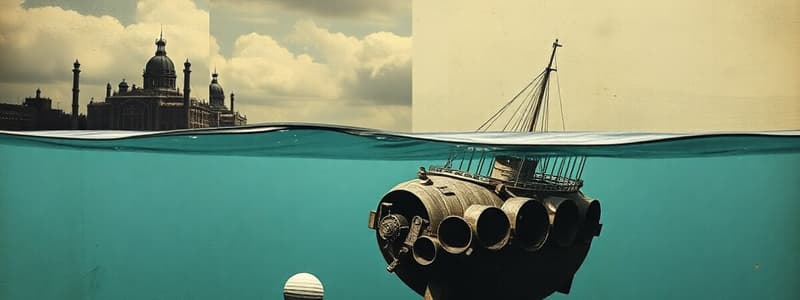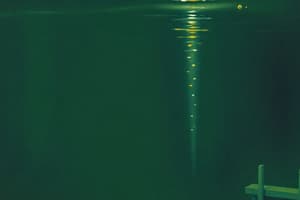Podcast
Questions and Answers
What is the main reason why a boat floats on water?
What is the main reason why a boat floats on water?
- The boat's shape creates a vacuum that pushes it upwards.
- The boat is lighter than the water it displaces. (correct)
- The boat's engine creates a force that pushes it upwards.
- The boat's material is specifically designed to be buoyant.
What is the relationship between pressure in fluids and buoyancy?
What is the relationship between pressure in fluids and buoyancy?
- Buoyancy is inversely proportional to the pressure of the fluid.
- Buoyancy is directly proportional to the pressure of the fluid. (correct)
- Buoyancy and pressure are independent of each other.
- Pressure in fluids is not related to buoyancy.
Which of these is NOT a consequence of an oil spill?
Which of these is NOT a consequence of an oil spill?
- Alteration of the marine food chain.
- Increased levels of oxygen in the water. (correct)
- Damage to human infrastructure and tourism.
- Contamination of marine life and ecosystems.
In a hydraulic system, how is force amplified?
In a hydraulic system, how is force amplified?
What is the main difference between a hydraulic system and a pneumatic system?
What is the main difference between a hydraulic system and a pneumatic system?
Flashcards
Buoyancy
Buoyancy
The upward force exerted by a fluid that opposes an object's weight.
Pressure in Fluids
Pressure in Fluids
The force exerted by a fluid per unit area on a surface.
Oil Spills
Oil Spills
The release of liquid petroleum hydrocarbons into the environment, especially marine areas.
Hydraulic Systems
Hydraulic Systems
Signup and view all the flashcards
Why Boats Float
Why Boats Float
Signup and view all the flashcards
Study Notes
Buoyancy
- Buoyancy is an upward force exerted by a fluid that opposes the weight of an immersed object.
- This force is a result of the pressure difference between the top and bottom of the object.
- The magnitude of the buoyant force is equal to the weight of the fluid displaced by the object.
- Archimedes' principle states that the buoyant force on an object is equal to the weight of the fluid displaced by the object.
- Objects will float if the buoyant force is equal to or greater than the object's weight.
- Density plays a crucial role in buoyancy. If an object's density is less than the fluid's density, it will float.
- If the object's density is greater than the surrounding fluid's density, it will sink.
- The buoyant force is independent of the shape or size of the object.
Pressure in Fluids
- Pressure in a fluid is the force exerted per unit area by the fluid on a surface.
- Pressure in a fluid increases with depth and the density of the fluid.
- Pascal's principle states that pressure applied to a confined fluid is transmitted equally in all directions throughout the fluid.
- Pressure is measured in Pascals (Pa).
- Pressure is transmitted throughout a fluid.
- Pressure in a fluid can be calculated by the formula: Pressure = Density * Gravity * Height.
- Atmospheric pressure is the pressure exerted by the Earth's atmosphere.
Oil Spills
- Oil spills are the release of liquid petroleum hydrocarbons into the environment, typically into bodies of water.
- These spills can have devastating effects on marine ecosystems, impacting wildlife, coastal communities, and the entire environment.
- Oil can coat animals, preventing them from insulating themselves or feeding.
- Oil often blocks sunlight necessary for aquatic plants, disrupting the food chain.
- Oil spills damage shorelines.
- Cleanup efforts typically involve containment, skimmers to remove oil on the surface, and biological methods to break down the oil.
- Prevention of oil spills is critical and involves better safety on oil rigs and transport tankers, enhanced maintenance of equipment, and improved regulatory oversight.
Hydraulic and Pneumatic Systems
- Hydraulic systems use liquids, typically oil, to transmit force.
- Pneumatic systems use gases, commonly air, to transmit force.
- Both systems work on the principle of Pascal's law, allowing for greater force amplification.
- Hydraulic systems benefit from incompressibility of liquids, meaning they maintain pressure throughout the system.
- This leads to a higher pressure amplification than in pneumatic systems.
- They are used in various applications, including brakes, machinery, and lifting heavy objects.
- Pneumatic systems are often preferred for their ability to control a variety of movements with different air pressures.
Why a Boat Floats on Water
- A boat floats because the buoyant force exerted by the water is greater than or equal to the weight of the boat.
- The boat displaces a volume of water equal to its submerged volume.
- The buoyant force, in accordance with Archimedes' principle, is equal to the weight of this displaced water.
- Boat design factors into its ability to float, including the shape (maximizing submerged volume), and the materials' density (less dense).
- If the weight of the boat is less than the weight of the water it displaces, the boat will float.
- A boat's hull has a shape designed to displace enough water to provide a buoyant force at least equal to the boat's weight.
Studying That Suits You
Use AI to generate personalized quizzes and flashcards to suit your learning preferences.





